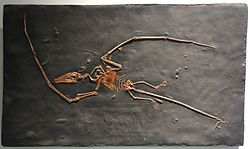Campylognathoides liasicus
|
Campylognathoides Temporal range: Early Jurassic, 182 Ma |
|
|---|---|
 |
|
| Cast of the Pittsburgh specimen of C. liasicus | |
| Scientific classification | |
| Kingdom: | Animalia |
| Phylum: | Chordata |
| Order: | †Pterosauria |
| Family: |
†Campylognathoididae Kuhn, 1967 |
| Subfamily: |
†Campylognathoidinae Kuhn, 1967 |
| Genus: |
†Campylognathoides Strand, 1928 |
| Type species | |
|
†Campylognathus zitteli Plieninger, 1894 |
|
| Species | |
|
|
Campylognathoides ("curved jaw", Strand 1928) is a genus of pterosaur, discovered in the Württemberg Lias deposits (dated to the early Toarcian age) of Germany; this first specimen consisted however only of wing fragments. Further better preserved specimens were found in the Holzmaden shale: basing on these specimens Felix Plieninger erected a new genus.
Compared to its contemporary from the same layers Dorygnathus, the snout on this genus is relatively short, though the skull is still in general elongated, be it much lighter built. The large eye sockets, placed low in the skull above a narrow jugal, have caused some researchers to speculate that Campylognathoides had especially acute vision, or possibly even a nocturnal lifestyle. The back of the skull is relatively high and flat, with a sudden downturn just in front of the eyes. The snout ends in a slender point curving a bit upwards at its very end. A large part of the snout is occupied by long bony nares. Below them a small triangular skull opening, the fenestra antorbitalis is present.
Reflecting the more shallow snout, the teeth of Campylognathoides are also short and not at all laniaries or fang-like as in the markedly heterodont Dorygnathus. They are conical and recurved but have a broad base with the point bevelled off from the inside forming a sharp and strong cutting surface. In the upper jaw there are four rather widely spaced teeth in the praemaxilla gradually increasing in size from the front to the back; the fourth pair of teeth is the largest. Behind them are ten smaller teeth in the maxilla, gradually decreasing posteriorely. In the lower jaw there are twelve to fourteen teeth present in C. liasicus, sixteen to nineteen in C. zitteli. The largest total number is thus 66.
According to a study by Kevin Padian there are eight cervical vertebrae, fourteen dorsals, four or five sacrals and up to 38 caudal vertebrae. The tail base is flexible with about six short vertebrae; behind them the caudals elongate and are stiffened by very long extensions allowing the tail to function as a rudder.
...
Wikipedia
